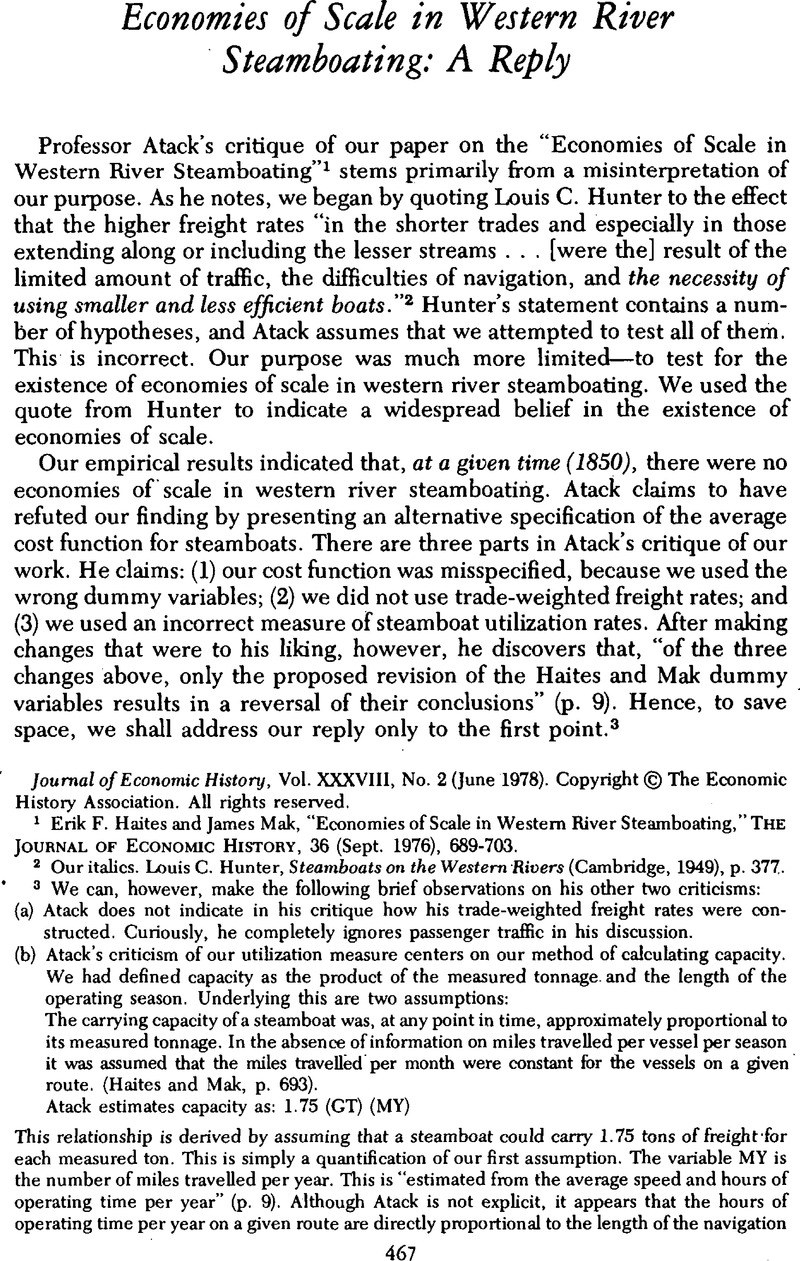No CrossRef data available.
Article contents
Economies of Scale in Western River Steamboating: A Reply
Published online by Cambridge University Press: 11 May 2010
Abstract

- Type
- Notes and Discussion
- Information
- Copyright
- Copyright © The Economic History Association 1978
References
1 Haites, Erik F. and Mak, James, “Economies of Scale in Western River Steamboating,” The Journal of Economic History, 36 (Sept. 1976), 689–703CrossRefGoogle Scholar.
2 Our italics. Hunter, Louis C., Steamboats on the Western Rivers (Cambridge, 1949), p. 377Google Scholar.
3 We can, however, make the following brief observations on his other two criticisms:
(a) Atack does not indicate in his critique how his trade-weighted freight rates were constructed. Curiously, he completely ignores passenger traffic in his discussion.
(b) Atack's criticism of our utilization measure centers on our method of calculating capacity. We had defined capacity as the product of the measured tonnage and the length of the operating season. Underlying this are two assumptions:
The carrying capacity of a steamboat was, at any point in time, approximately proportional to its measured tonnage. In the absence of information on miles travelled per vessel per season it was assumed that the miles travelled per month were constant for the vessels on a given route. (Haites and Mak, p. 693).
Atack estimates capacity as: 1.75 (GT) (MY)
This relationship is derived by assuming that a steamboat could carry 1.75 tons of freight for each measured ton. This is simply a quantification of our first assumption. The variable MY is the number of miles travelled per year. This is “estimated from the average speed and hours of operating time per year” (p. 9). Although Atack is not explicit, it appears that the hours of operating time per year on a given route are directly proportional to the length of the navigation season for the route. This is virtually identical to our second assumption. Thus, conceptually, there is virtually no difference between the two measures of capacity and hence utilization. The results reported by Atack in column 10 ofTable 1 use our measure of utilization. Those reported in column 3 of Table 2 use his measure of utilization. A comparison of these two estimates reveals that the coefficients and standard errors of all variables, except the constant terms and route dummies, are identical.
4 The ![]() 2 in his specification is slightly lower than ours, although one could not comfortably make a choice between the two specifications on the basis of that difference alone.
2 in his specification is slightly lower than ours, although one could not comfortably make a choice between the two specifications on the basis of that difference alone.
5 The negative relationship would be weakened as long as the coefficients of the dummies are significant. Note that if the dummies are significant, all the coefficients in which the dummies are left out are biased, because the cost function is misspecified.
6 Atack alleges that “by demonstrating that constant returns to scale prevailed, [we] have substantiated earlier claims [our italics] that steamboating in America was characterized by perfect competition.…” It should be pointed out that our intent was not to prove that steamboating was characterized by perfect competition. The proof of perfect competition can be deduced from the descriptive characteristics of the industry itself. Hunter, op. cit.; and Haites, Erik F., Mak, James, and Walton, Gary M., Western River Transportation (Baltimore, 1977)Google Scholar.




